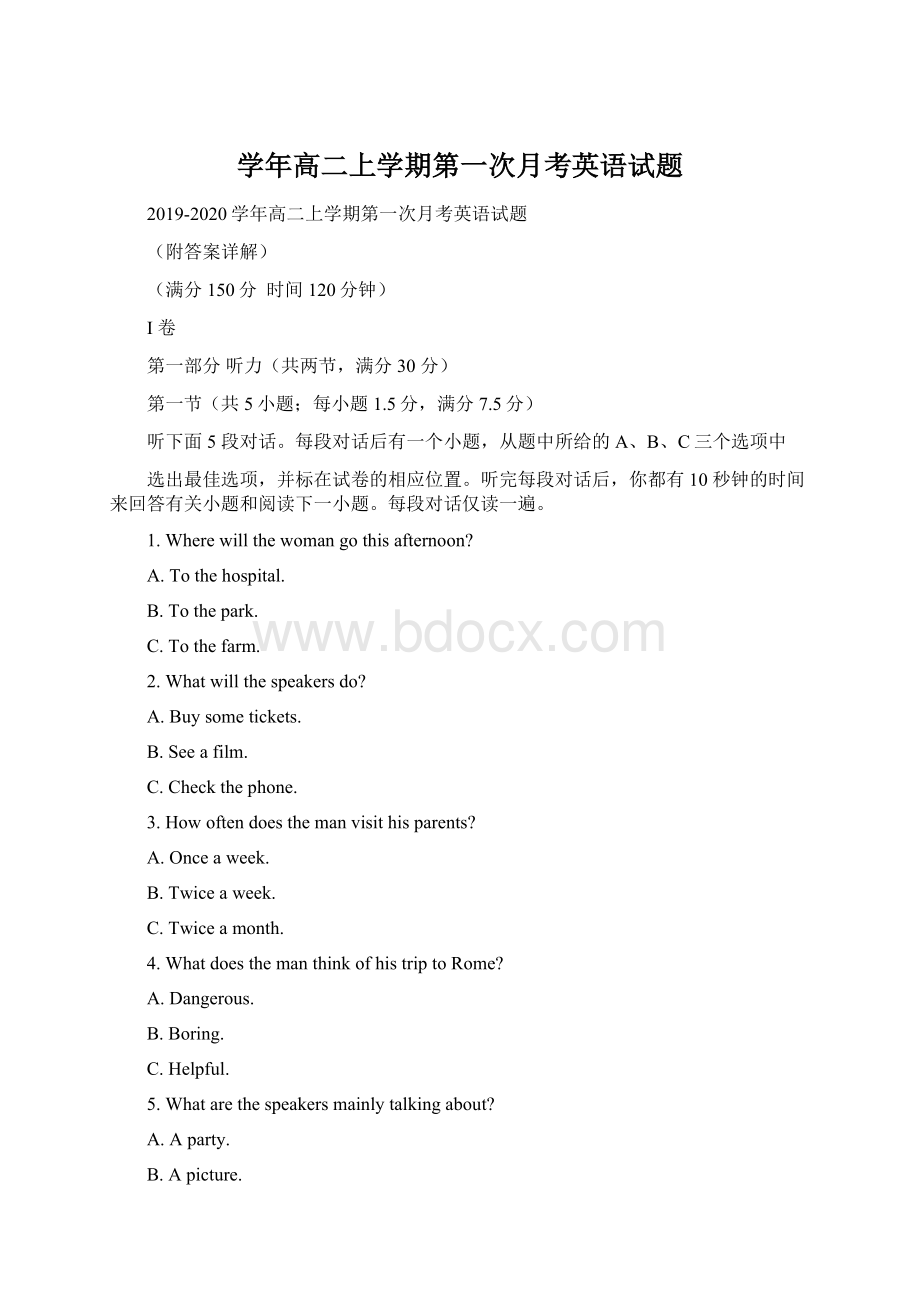学年高二上学期第一次月考英语试题.docx
《学年高二上学期第一次月考英语试题.docx》由会员分享,可在线阅读,更多相关《学年高二上学期第一次月考英语试题.docx(20页珍藏版)》请在冰豆网上搜索。

学年高二上学期第一次月考英语试题
2019-2020学年高二上学期第一次月考英语试题
(附答案详解)
(满分150分时间120分钟)
I卷
第一部分听力(共两节,满分30分)
第一节(共5小题;每小题1.5分,满分7.5分)
听下面5段对话。
每段对话后有一个小题,从题中所给的A、B、C三个选项中
选出最佳选项,并标在试卷的相应位置。
听完每段对话后,你都有10秒钟的时间来回答有关小题和阅读下一小题。
每段对话仅读一遍。
1.Wherewillthewomangothisafternoon?
A.Tothehospital.
B.Tothepark.
C.Tothefarm.
2.Whatwillthespeakersdo?
A.Buysometickets.
B.Seeafilm.
C.Checkthephone.
3.Howoftendoesthemanvisithisparents?
A.Onceaweek.
B.Twiceaweek.
C.Twiceamonth.
4.WhatdoesthemanthinkofhistriptoRome?
A.Dangerous.
B.Boring.
C.Helpful.
5.Whatarethespeakersmainlytalkingabout?
A.Aparty.
B.Apicture.
C.Acity.
第二节(共15小题;每小题1.5分,满分22.5分)
听下面5段对话或独白。
每段对话或独白后有几个小题,从题中所给的A、B、C三个选项中选出最佳选项,并标在试卷的相应位置。
听每段对话或独白前,你将有时间阅读各个小题,每小题5秒钟;听完后,各小题将给出5秒钟的作答时间。
每段对话或独白读两遍。
听第6段材料,回答第6、7题。
6.Whatwillthemandofirst?
A.Savethefiles.
B.Goouttoeat.
C.Orderfoodonline.
7.Whatistherelationshipbetweenthespeakers?
A.Husbandandwife.
B.Fellowworkers.
C.Roommates.
听第7段材料,回答第8、9题。
8.Whatkindofmusicdoesthewomanlikebest?
A.Pop.
B.Classical.
C.Rock.
9.Whatdoesthemanplantodotonight?
A.Gotoaconcert.
B.BuysomeCDs.
C.Stayathome.
听第8段材料,回答第10至12题。
10.HowdidthewomanfeelaboutLydia’swords?
A.Upset.
B.Thankful.
C.Pleased.
11.WhatcanwelearnaboutLydia?
A.Sheisthewoman’scolleague.
B.ShecomesfromRussia.
C.Shehasmanyfriends.
12.Whatdidthewomanbuyatlast?
A.Adress.
B.Ashirt.
C.Apairofshoes.
听第9段材料,回答第13至16题。
13.Whenwillthebookreadingtakeplace?
A.Tomorrow.
B.Thedayaftertomorrow.
C.Nextweek.
14.Whoisgoingtodothereading?
A.John.
B.George.
C.Francis.
15.Whatwillthemandotomorrownight?
A.Attendthebookreading.
B.Gobacktohishometown.
C.HavedinnerwithJudy.
16.WhatwillJudydonextmonth?
A.Getmarried.
B.GotoSingapore.
C.VisitFrance.
听第10段材料,回答第17至20题。
17.Howmanybooksdoesthelibraryhold?
A.Above2,500.
B.Above15,000.
C.Above25,000.
18.Whyisthelibrarygettingricher?
A.Itgetssupportfromthegovernment.
B.Moreandmorepeopledonate.
C.Thevisitorsleavetheirownbooksthere.
19.Whatcanweknowabouttheshelves?
A.Theyprotectthebooksagainstwater.
B.Theyaremadeofcommonwood.
C.Theycanstandwindandsun.
20.Whatisthespeakertryingtodo?
A.Introduceacharityproject.
B.Tellpeopleabeachlibrary.
C.Encouragepeopletodomorereading.
第二部分阅读理解(共两节,40分)
第一节(共15小题;每小题2分,共30分)
阅读下列短文,从每题所给A、B、C、D四个选项中,选出最佳选项,并在答
题卡上将该项涂黑。
二.阅读理解:
A
HongKongandParisarenowtheworld’smostexpensivecitiestolivetogetherwithSingapore.It’sthefirsttimethatthreecitieshavebeenforthefirstplaceinthe30-yearhistoryoftheEconomistIntelligenceUnit’s2019WorldwideCostofLivingSurvey.
HongKongmovedupthreeplacestojoinSingapore,whichhasbeentheworld’smostexpensiveplacetoliveforthelastfiveyears.Paris,whichhasbeenoneofthetop10since2003,movedupthisyearfromthesecondmostexpensivelastyear.Paris,SingaporeandHongKongareall7percentmoreexpensivetolivethanNewYork.
ThesurveyreleasedonTuesdaycomparesthecostof160items,suchasfood,drink,transport,utilitybills,andrent,in133cities.Thetop10mostexpensivecitiesarelargelyfromAsianandEuropeancities.
●Japan’sOsakamovedupsixpositions,andnowsharesthefifthplacewithSwitzerland’sGeneva.
●NewYorkandLosAngelesaretheonlyNorthAmericancitiesinthetop10,toseventhplace,apositionitshareswithDenmark’sCopenhagen.
●LosAngeleswasnamedthe10thmostexpensivecityintheworld,alongwithIsrael’sTelAviv.SanFranciscohasalsobecomeamoreexpensiveplacetolivein.
●SwisscitiesZurichandGeneva,cominginatfourthandfifth(withOsaka),hadthehighestcostswhenitcametohousehold,personalcareandentertainment.
21.Whichcityrankstenthintheworld’smostexpensivecitiestolivein?
A.HongKong.B.TelAviv.C.Geneva.D.SanFrancisco.
22.Wheredothetop10mostexpensivecitiestoliveinmainlycomefrom?
A.AsiaandEurope.B.AsiaandAmerica.
C.AmericaandAfricaD.AmericaandEurope.
23.Whichsectionofthenewspaperdoesthetextmostlyappearin?
A.Education.B.Amusement.C.Finance.D.Sports.
B
Theoceanwaves(波浪)aregettingstrongerasaresultofclimatechange,whichmightcausedangersforcoastcitiesinthefuture,accordingtothelateststudypublishedinthescientificjournalNature.Researchersfoundthatwaveshaveincreasedinstrengthby0.41percentperyearsince1948.Thischangeisrelatedtotheincreasingsea-surfacetemperature,whichisdrivingsealeveltoriseandbringingmoreseriousandextremeweather.
Thisrelationshipisimportant,asitshowsthat“globalwavepowercanbeavaluablereminderofglobalwarming,carbondioxideconcentration,theglobalsealevelriseortheglobalsurfaceatmospheretemperature,”saiddirectorofresearchattheEnvironmentalHydraulicsInstituteatSpain’sUniversityofCantabria.
Thestudyrevealsalong-termandincreasingwaveenergy.Theeffectsofthisincreaseareparticularlyclearduringthestormseasons.Astormwasformedinthewinterof2013-2014intheNorthAtlantic,whichaffectedthewestcoastofEurope.“Thestormin2017intheCaribbeanremindedpeopleofthehugeeconomiceffectscomingfromcoastalstorms,”saidthestudy.
Researchershopethefindingscouldprovideamorecompleteunderstandingofthedangersfacedbycoastalcitiesinthecomingdecades.“Ourresultsshowthatignoringthechangesinwavepowerandhavingsealevelrisemaycauseustothinklittleofclimatechange,whichwillresultinnotenoughorpoorpreparation,”warnedtheauthorFernandoJ.Mendez,aprofessorattheUniversityofCantabria.
Thefindingsmaywarngovernmentstobetterprotectthepopulationinthecoastalcitiesandinfrastructure(基础设施)suchasportsandharborsbybuildingcoastaldefenses.
24.What’saresultofstrongeroceanwaves?
A.Climatebeginstochange.B.Peoplelivingnearthecoastfacedanger.
C.Oceansarebeingpolluted.D.Citieswillmovetootherplaces.
25.Whichofthefollowingmayleadtostrongeroceanwaves?
A.Therisingsea-surfacetemperature.B.Coastalcities.
C.Morepopulation.D.Moreportsandharbors.
26.Whichofthefollowingbestexplains“reveals”underlinedinparagraph3?
A.Affects.B.Invents.C.Selects.D.Shows.
27.Whatistheprobablepurposeofthestudy?
A.Topredicttheclimatechange.
B.Toadvertisetheresults.
C.Towarngovernmentsandcoastalpeopleoftheincreasingoceanwaves.
D.Toencouragepeopleinthecoastalcities.
C
Whatisthemostpopularwaytotravelinthewholeworld,notcountingahumanbeing'stwolegs?
Yousaybycar?
No.Train?
Wrongagain.Airplane?
I'msorry,butyou'renotevenclose.Themostpopularwayofgoingfromoneplacetoanotherisbybicycle.AnditisasurprisetomostAmericans.Afterall,weseethousandsofcarseachday.Wedon'tseenearlyasmanybikes.
IntheUnitedStatesmostbikeridersareeitheryoungpeopleoradultsbicyclingforexercise.AboutninemillionbikesaresoldinAmericaeachyear.Nearlythreemillionaresoldtoadults.Therestaretochildren.Butintherestoftheworld,farmorepeopleusethebikeastheirmainwayoftraveling.Theyridebikestowork,toschool,andtostores.
Bicycleshavebeenaroundforalongtime-about300years.Youwouldnotliketoridearoundonthoseearlybikes,though.Theydidn'thaveanypedals(脚蹬).Theridershadtopushalongwiththeirfeet.Andthisbikeonlywentstraightahead.Therewasnowaytoturnthefrontwheel.Iftheriderwantedtochangedirection,heorshehadtogetoffandmovethebicycle.Whenpedalswereputonthefrontwheels,ridingbecameeasier.Themostpopularkindofbikeinthelate1800shadaveryhighfrontwheelandasmallbackwheel.Itwasalongfalltotheground!
Anotherproblemwasthattherewerenorubbertires(橡胶轮胎).Sobikewascalledthe"Boneshaker"atthattime.Theninthe1880s,air-filledrubbertireswereputonthebicycle'swheels,whichmadepeoplefeelmorecomfortable.Sincethenthebicyclehasnotchangedverymuch.Ofcoursebikescomeindifferentshapesandcolorsnow,butthemaindesignisstillthesame.
28.ComparedwiththoseinAmerica,bikesintherestoftheworld.
A.aremuchcheaperB.aremorepopular
C.aremainlyusedbychildrenD.aremainlyusedtodoexercise
29.Whydidpeopledislikeridingearlybikes?
A.Theyweretoolarge.B.Theyweredangerous.
C.Theywerehardtocontrol.D.Theyweretoohighformanypeople.
30.Theunderlinedword"Boneshaker"inthelastparagraphshowsthebikewas.
A.uncomfortableB.slowC.brokenD.old
31.Theauthorwrotethistextmainlyto.
A.warnreadersaboutbicyclesafety.
B.introducethenewshapesofbicycles.
C.encouragereaderstobicycleforexercise.
D.tellreadersthehistoryofbicycles.
D
Noteveryparentlooksateducationinthesamelight.Somepreferthepublicschoolapproach,whileotherparentswouldrathertaketheirchild`slearningexperienceintotheirownhandsathome.
Reportsstatetherehasbeena75percentincreaseinhomeschoolingintheUSsince1999.OvertwomillionAmericanchildrenarehomeschoolednow.Parentscantailor(定做)theirchildren'sclasses,environmentandscheduleinordertofittheneedsofthefamily,whichisveryconvenient.
Thereisadarksidetothiseducationalfreedom,though.Homeschoolingiscompletelylegal,butinmoststatesparentsareonlyrequiredtosignapaperexpressingtheirintentiontohomeschooltheirchild.Itisonlywhenthereisdoubtofmisconductormistreatmentthatofficialswilllookm